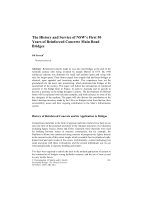Bridges

Reinforced concrete made its way into road bridges at the start of the twentieth century after being invented by Joseph Monier in 1875. By 1950 reinforced concrete was dominant for small and medium spans and vying with steel for longer spans. Their forms ranged from simple slab and beam bridges to classical, open spandrel and bowstring arches. This experience base set the groundwork for the move into prestressing, which dominated the bridges of the second half of the century.
This paper will follow the introduction of reinforced concrete to the bridge form in France, its path to Australia and its growth to become a mainstay in the bridge designer’s armory. The development of different forms will be explained with relevant examples, and with reference to some of the key designers of the medium. The paper will also discuss the contribution to the State’s heritage inventory made by the 150 or so bridges extant from that era, their serviceability issues and their ongoing contribution to the State’s infrastructure system.
